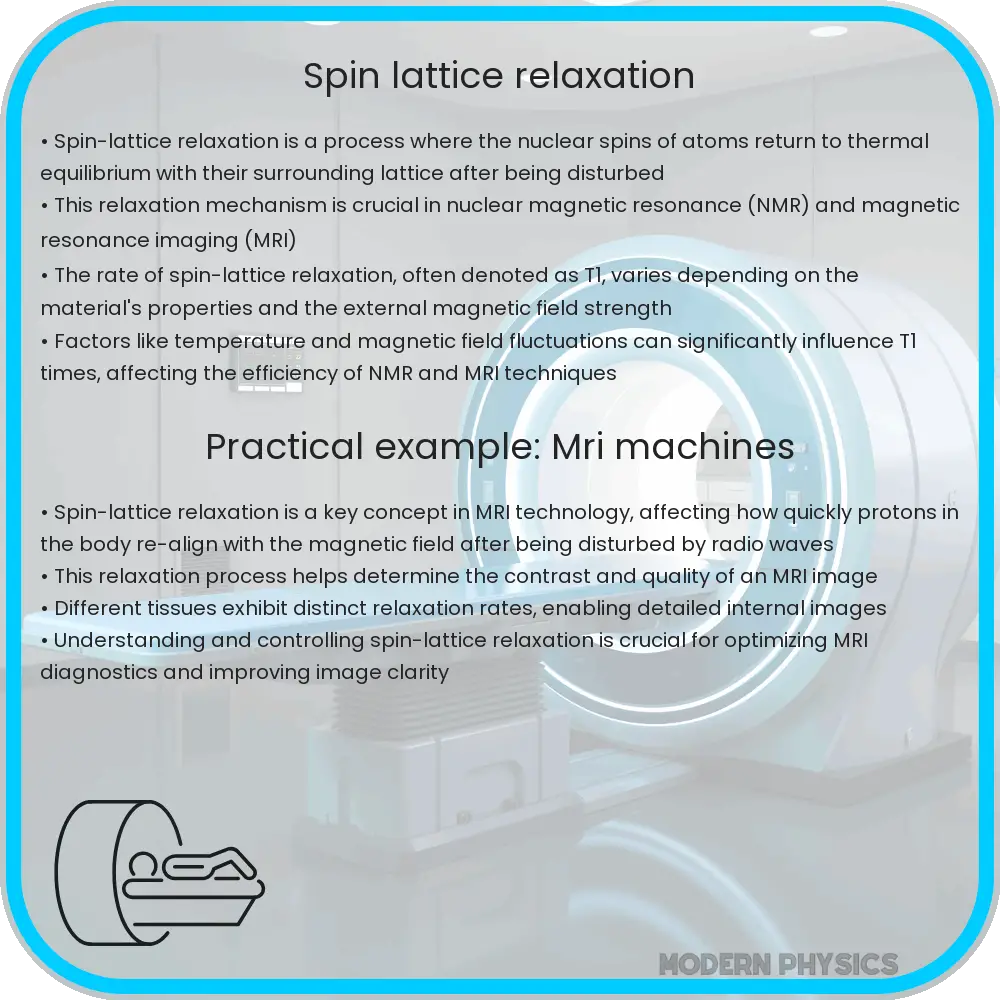Spin lattice relaxation is a key process in NMR and MRI, where nuclear spins in a lattice return to equilibrium after disturbance, crucial for understanding material and biological dynamics.

Understanding Spin Lattice Relaxation
Spin lattice relaxation is a fundamental concept within the realm of nuclear magnetic resonance (NMR) and magnetic resonance imaging (MRI). It represents a key mechanism by which the magnetization vector of nuclear spins in a lattice returns to its equilibrium state after being disturbed. This process is also known as longitudinal relaxation or T1 relaxation. Understanding how spin lattice relaxation works offers insights into the molecular and atomic scale dynamics of materials and biological tissues.
Key Principles of Spin Lattice Relaxation
The primary principle behind spin lattice relaxation is the interaction between the magnetic moments of nuclei and their surrounding lattice environment. When a sample is placed in a magnetic field, the magnetic moments of the nuclei align with the field. An external radio frequency (RF) pulse can then be used to perturb this alignment, flipping the spins into a higher energy state. Once the RF pulse is switched off, the system begins to relax back to its original state, primarily due to interactions with the surrounding lattice or environment. The relaxation rate, or how quickly the spins return to equilibrium, depends significantly on these interactions.
Mathematically, the return to equilibrium can be described by the following exponential function:
M(t) = M0(1 – e-t/T1)
Here, M(t) represents the magnetization at time t, M0 is the equilibrium magnetization, and T1 is the spin-lattice relaxation time. The value of T1 is a crucial factor in determining how quickly a system reaches thermal equilibrium and is influenced by the temperature, magnetic field strength, and properties of the material or tissue.
Applications of Spin Lattice Relaxation
- Material Science: In materials science, measurements of T1 relaxation times help in determining molecular dynamics, phase transitions, and compositions in polymers and metals.
- Medical Imaging: In MRI, the T1 relaxation times of tissues contribute significantly to the contrast in an image. Different tissues have distinct T1 values, allowing radiologists to distinguish between normal and pathological conditions.
- Chemistry and Biochemistry: Spin lattice relaxation provides valuable information about chemical environments, binding states, and conformational changes in molecules. It assists chemists in understanding how molecular structures affect their dynamics and interactions.
While the principles of spin lattice relaxation are extensively utilized in research and technology, the complexity of interactions and factors affecting T1 demand a deeper understanding and precise measurements. These insights not only enable advancements in NMR and MRI technologies but also broaden the understanding of material and biological systems at the atomic and molecular levels.
Challenges in Measuring Spin Lattice Relaxation
Accurate measurement of T1 relaxation times is critical but can be challenging. Several factors can influence the precision of these measurements:
- Sensitivity of Equipment: The accuracy of instruments such as NMR spectrometers and MRI scanners plays a significant role. Higher sensitivity and better calibration of the equipment lead to more reliable data.
- Sample Conditions: Variations in temperature, purity, and homogeneity of the sample can alter T1 measurements. Consistent sample preparation is vital for reproducible results.
- External Interferences: Electromagnetic noise and vibrations can affect the measurements. Facilities often require specialized environments to minimize these disturbances.
Advancements in technology and techniques continue to improve the accuracy and applicability of T1 relaxation time measurements, making them indispensable in both scientific research and practical applications.
Conclusion
Spin lattice relaxation is a pivotal concept in understanding the dynamics at the molecular and atomic levels in various materials and biological systems. By exploring the fundamental mechanisms through which nuclear spins interact with their environment, scientists and engineers can utilize these principles in numerous applications ranging from material science to medical imaging. Despite the complexities involved in precisely measuring T1 relaxation times, ongoing advancements in NMR and MRI technology are enhancing our capabilities to observe and analyze these phenomena. This not only aids in pushing the boundaries of scientific research but also in improving diagnostic procedures in medicine, contributing to more detailed and accurate assessments of tissue health. Overall, the study of spin lattice relaxation continues to offer valuable insights into the microscopic world, reinforcing its significance in both theoretical and applied physics.
